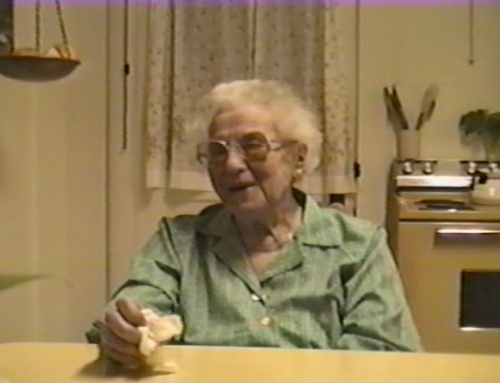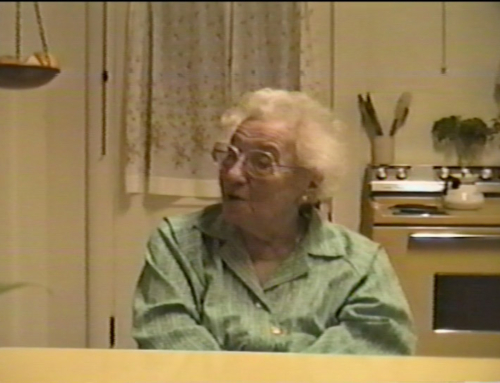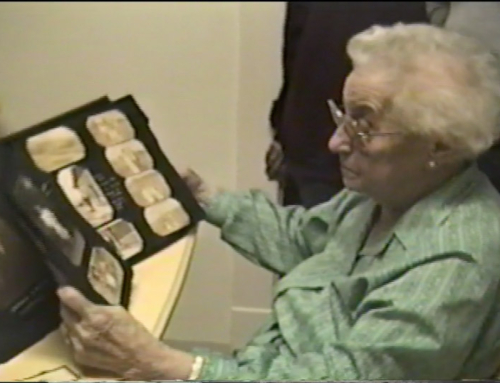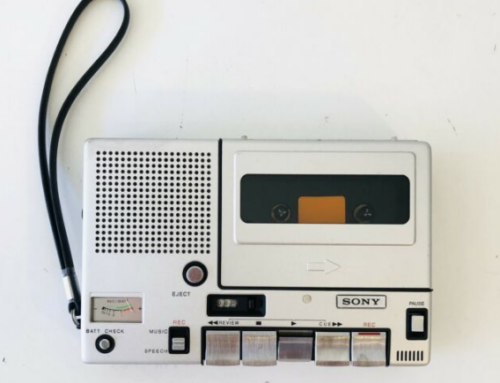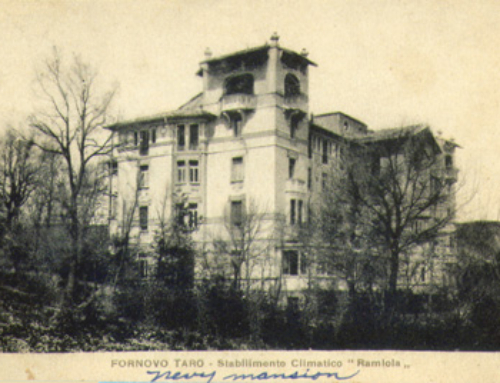By Joan Lander
July 26, 2001
At the instigation of my sister, Alex Lander, who is researching the early days of the Nevy’s in America for a novel, Mom (Florence) and I drove with her to several Pennsylvania towns, including Colver, Ebensburg, Vintondale and Blairsville.
But before we left Cumberland, we did some reconnaisance. After church on Sunday we visited the factory and climbed up the outside pipes to get in through an open window. Inside it was a “disastro” (the word Arnerio used to describe the broken down old houses at Castagna). The ceiling and wall materials had been ripped off and piled up. Dust, dirt and broken glass were everywhere. The place looked like it had been gutted in preparation for demolition.
We salvaged some printed Alpine Eagle macaroni boxes and labels. We also saw evidence of Bratti’s frantic efforts to make a go of pasta-making. There was a mock-up of a box with a Marco Polo label that looked like it had been designed by PR people. Strewn around on the floor were sample packages from about 30 other pasta makers; they must have been researching the competition. There was a list of drying time, temperature and humidity settings for each type of pasta, from elbows to Marguerites.
I looked for and finally found a drying rod, the wooden dowel that was used to hang drying spaghetti. Brought it home for Laura, who makes pasta from scratch.
Alex tried to get an idea of where the house was where Nonnie and Nonno first lived.
After an unexpected adventure, fleeing the tracks behind the factory before the approach of an oncoming train, we left.
On Monday, we visited the C & O Canal and railroad museum, looking for early maps of Cumberland. The ca. 1918 maps on the museum exhibits showed that the factory was located near the yards where canal barges were constructed. The picture of what Nonnie and Nonno’s life was like in those early days of the factory started to come alive.
Seeking more maps, we were referred to the county engineers offices on Mechanic Street, where we found and were given xeroxes of several maps, dating back to 1938. We had been looking for earlier ones, but couldn’t find them. However, we did see a photo exhibit of two devastating floods that hit Cumberland, in 1924 and 1936. The first one wiped out commercial activities on the canal. The 1936 flood photos show people rowing boats on Cumberland’s downtown streets. Mom said she remembers our grandparents taking in a family whose house was flooded.
The people at the county engineers office let slip the fact that the new owner of the factory was the Cumberland Outdoor Club. We found their current location (also on Mechanic Street) and dropped in to chat with the manager, who said they planned to tear down the old part of the factory and renovate the newer part into their new club headquarters. They have about 500 members and it seemed as though, contrary to their name, they mostly use the club for dinners and drinking.
After that, a trip to Caporale’s, where we learned that the secret to the bread that we all remember was an underground oven, built into the earth under their old facility in South Cumberland.
We visited Ebensburg, Pennsylvania, the seat of Cambria County, and found several documents of interest at the county courthouse, including Nonnie and Nonno’s marriage certificate and the naturalization papers for several of the Nevy brothers and Teresina.
The marriage certificate was dated 1915, but on it Nonnie listed her age as 18. Even so, there was an additional document signed by Giacomo Galli (signing as Jacob Galli) giving his consent to the marriage of a child. One of the witnesses to the signing was Italina Nevy of Colver.
The naturalization papers contain a lot of interesting history, including the date each of the Nevy brothers first came to America, what port they left from in Europe, the name of the ship, and their signatures renouncing all allegiance to any foreign potentate, especially Victor Emmanuel III, King of Italy. We found Ralph Nevy’s Declaration of Intention to be naturalized, but could not find his actual citizenship papers. We’re thinking that perhaps he completed the process after he moved to Cumberland.
After a visit to Colver, looking for the bar where Giacomo worked and talking to several townspeople who remembered the Nevy Brothers store in Vintondale, we bedded down for the night at a motel.
The next day we traveled to Vintondale. Alex had written for and received permission to go up into the rooms over the old Nevy Brothers store, which is still in use as a store. Mom experienced a flash from the past, remembering who slept in what room, recognizing the linoleum and wallpaper patterns, pointing out where the dining room used to be, where Nonnie had nursed Catarina Nevy during the last week of her life, and recounting all the adventures she and her sisters and cousins had.
Up in the attic, we found old papers from the store, with dates as early as 1912. They were mostly ledgers (kept by Emma), checks, and invoices for various products — maple syrup, butter, thread, boots and rubbers. There were several copies of an Italian-language novella. Everything told a story of running a business in those days. I salvaged a bunch of these dirty, dusty papers and they’re now sitting safely inside ziplock bags in my editing room. The trick will be to scan them into a computer without getting the dust of the ages all over our house.
The river that runs behind the store in Vintondale is still orange in color — sulfur wastes from the coal mines. Mom said she was always afraid to go in the river for fear her shoes would turn orange. (This didn’t stop Viola from once losing a shoe to the river after kicking her foot out.)
We learned from the woman that ran the store that the people of the area are trying to clean their watershed and, as a first step, are draining the water out of the mines. As a result, you can see small geysers in the middle of the river bed, where the mine water is being pumped out. Although the project has only just begun, fish are beginning to appear in the stream once again.
The trip was a wonderful and enlightening step into the past for us. My thanks to Alex, the youngest grandchild of Nonnie and Nonno, for making it all happen.
For those of you who want to know more about the history of the town and some stories about the Nevy brothers, there is a wonderful book out entitled Delano’s Domain – A History of Warren Delano’s Mining Towns of Vintondale, Wehrum and Claghorn, Volume I, 1789-1930 by Denise Dusza Weber.
It’s published by the A. G. Halldin Publishing Company, Inc., Indiana, Pennsylvania 15701-0667. ISBN 0-935648-33-x.

